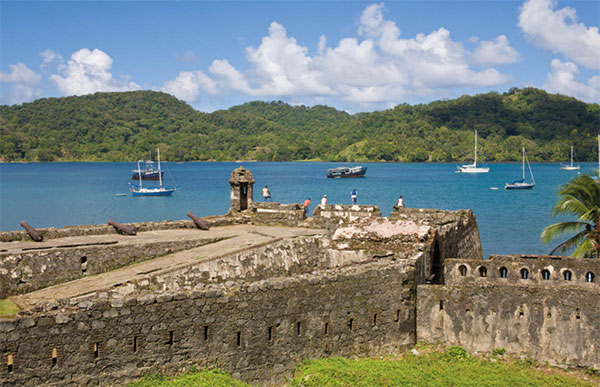Portobelo to Isla Grande
Approximately 43km (27 miles) east of Colón lies the sleepy seaside town of Portobelo 8 [map] , which was one of the wealthiest ports in the Spanish Caribbean from the 16th to early 18th centuries, thanks to much of the silver and gold from South America passing through here before being shipped off to Europe. Portobelo today is relaxed as they come, a small grid of cobblestone streets fronting the yacht-filled bay, with jagged, rainforest covered mountains towering behind it.

The ruins of Castillo Santiago de la Gloria, Portobelo.
Getty Images
Buccaneers like Henry Morgan and the British Admiral Edward Vernon made their mark on the city, and as a result, defensive fortifications were built around the bay. Much of the original architecture has been well preserved, helping Portobelo attain Unesco World Heritage Status in 1980. Fronting the plaza is the Customs House, dating to 1630 but partially rebuilt after cannon attacks and fire over the centuries. It is said that one third of the gold in the world once passed through its door, and today it’s a small museum. Beside the Customs House is Fuerte San Jerónimo, which dates back to 1664 and features a row of cannons facing the bay.
The Iglesia de San Felipe (hours vary; free), a block from the plaza, is home to the celebrated ‘Black Christ’ statue, which is honored with a festival each October 21. The statue was, as legend has it, left behind by a ship en route to Cartagena and after residents prayed to it during a cholera epidemic they were miraculously spared.
The quaint village is as rich culturally as it once was economically. The residents are descendants of African slaves brought during the Spanish colonial era, who call themselves ‘congos.’ They maintain rich expressions of dance, music, and art, which come alive during festivals throughout the year. An art gallery and cultural center called La Casa Congo (www.fundacionbp.org), which is associated with the luxury hotel El Otro Lado (www.elotrolado.com.pa) across the bay, helps organize performances for visitors and rents kayaks, to explore the mangroves and fortifications that can only be accessed by water.
Roughly 20km (13 miles) east of Portobelo in La Guaira, just beyond Adriana’s Afro-Panamanian seafood restaurant, boats run offshore to Isla Grande, a relaxed island escape with a few good beaches and decent snorkeling. There are a few small hotels and restaurants, which open and close with the seasons. Amenities here are quite basic.

The ruins of Castillo Santiago de la Gloria, Portobelo.
Shutterstock
The Pacific coast
West from Panama City, the Pan-American highway runs parallel to the Pacific coast, passing a string of beaches that become progressively more attractive the farther away you get from the capital. Many wealthy Panamanians and ex-pats have beach houses or condos here, which usually remain empty during the week. Seaside golf courses and a few mega-resorts are scattered about as well. The landscape becomes more rugged at the Azuero Peninsula, a cowboy country known for wild parties, that’s seeing its first signs of major development on its more remote beaches. At the Gulf of Chiriquí, the coast is at its most dramatic, with wild islands and fine whale-watching.
Near Pacific Beaches
The nearest beach to Panama City is Playa Bonita, just beyond the Bridge of the Americas, where there is a mega-resort, the Westin Playa Bonita Resort & Spa (www.marriott.com), though little else. The lengthy beach at Playa Coronado, 83km (51 miles) from the city, is one of the most developed on the coast, with supermarkets and lots of residential units. Coronado feels older, yet not nearly as cookie cutter in style as some of the developments farther west.
Santa Clara 9 [map] , 113km (70 miles) from the city, and neighboring Farallón are the prettiest beaches on the coast and attract more tourists than locals. Santa Clara is more public, with condo towers and mostly small hotels, aside from the all-inclusive Sheraton Bijao Resort (www.eveniahotels.com). Farallón, which is better known as Playa Blanca, is home to the massive, 852-room Royal Decameron Beach Resort, Golf, Spa & Casino (www.decameron.com), as well as the Buenaventura complex, anchored by a JW Marriott hotel and a Jack Nicklaus-designed golf course that is one of the best in Central America.
El Valle de Antón
Inland, 28km (17 miles) from the Pacific, is El Valle de Antón ) [map] , aka El Valle, which sits within the crater of the world’s second-largest extinct volcano. With an altitude peaking at 762 meters (2,500ft), El Valle has year-round cooler conditions than the coast, making it an attractive weekend escape from Panama City, less than two hours away. On Sundays, vendors from around the region come to town to sell handicrafts and produce, including Ngäbe and Emberá people, who sell traditional cloths and baskets.